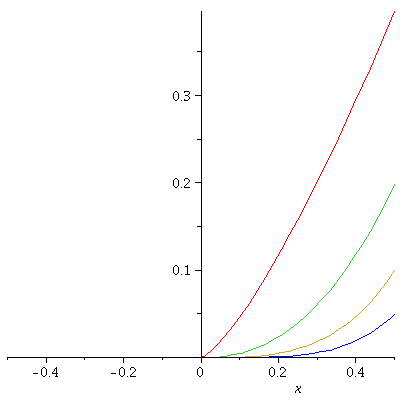4th Funky Functions: C^n Function.
A function that is n-times differentiable,
but not (n+1)-times differentiable
Let n be an integer and consider the function:
![]() : [-a, +a] --> R
: [-a, +a] --> R
![]() (x) =
(x) = ![]()
so
![]() (x) =
(x) = ![]()
So, for some constant ![]()
![]()
![]() (x) =
(x) = ![]()
which is not differentiable at x=0.
For this example, do you really care what
the constant ![]()
Below you can investigate
g_k, g_{k+1}, g_{k+2}, .... g_{k+enough}
for your choice of "k" and "enough" .
There is:
1) SeqOFgn = sequence of the functions:
g_k, g_{k+1}, g_{k+2}, .... g_{k+enough}
2) nthDerOFgn = sequence of the functions:
kth derivative of g_k, (k+1)st derivative of g_(k+1), ...., until enough
3) The functions
g_k, g_{k+1}, g_{k+2}, .... g_{k+enough}
all ploted on the some grid with domain [-a, a]
| > | restart;
k:= 1; enough := 3; a := .5; g := n -> (x)^(n+1/3); SeqOFgn := [seq(g(n), n=k .. k+enough)]; nthDerOFgn := [seq(diff(g(n), x$n), n=k .. k+enough)]; plot( SeqOFgn , x= -a .. a); |
 |
*) disclaimer ....
Maple is only giving me the plots on [0,a] ....
by symmetry I can easily envision what
the plot on the whole of [-a,a] looks like ....
but I'm not going to waste time trying to figure out Maple 11 ...
the last time I used Maple they were at Maple 4 ...
| > |
Think about what the plot is saying.
Why does the 1st derivative of g_1 not exist at x=0?
Well, the derivative from the right & left is "+ infinity",
ie., the tangent line is trying to be vertical.
Think about what happens each time you take
a derivative of some derivative of a g_n ...
and the "steepness" of the g_n's.
That's all.